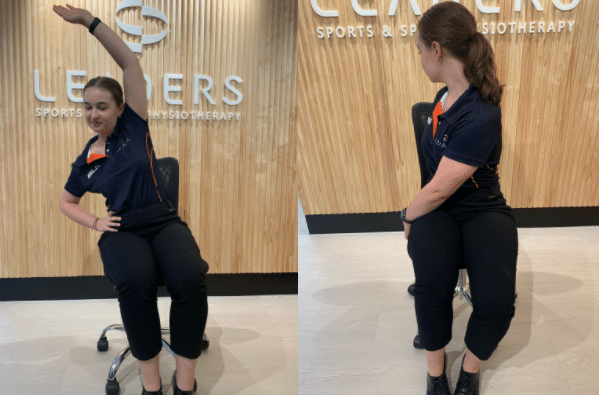Have you ever wondered why you can still get back pain even though you’ve had every modification to your desk setup? Haven’t found the solution despite Googling what’s the best office chair for back pain? You try to maintain “good sitting posture” throughout the day but the tightness still builds up?
There has been a big shift in posture awareness over the last few decades within corporate businesses and with more accessibility to the internet. Every man, woman, and their dog knows about the “90/90 posture” at work, but what does the research actually say about posture?

According to the WHO (World Health Organisation), 60-70% of people in industrialized countries get non-specific lower back pain in their life. This is likely because office jobs are more common and encourage a sedentary lifestyle. To combat this issue, big companies have poured money into ergonomic assessments, education, and setups to ensure their employees “prevent” back pain. As research has shown a correlation between prolonged posture and pain, a clear message has been ingrained into workers over the years that there is only one optimal posture – the 90/90. This however has been disproven suggesting that good sitting posture requires variability in postures over a period of time.
Now I’m not saying to scrap ergonomic setups. They do provide comfort and relief so you can sit for longer periods of time, but here are some other helpful tips that you can implement today in the office!
1. Take frequent short breaks
Take regular movement breaks throughout the day! Ideally, postures should be changed every 20 minutes but realistically, it’s likely going to be every hour. This can be as simple as going to the bathroom, getting a coffee, walking to the printer, or a few quick stretches. The aim is to build good long-term habits. The more simple something is the more likely you’ll be consistent with it. Start small and build up.
2. Lumbar support while seated
There is a tendency to slouch when sitting for longer periods of time. The body needs to move or muscles can become fatigued. If you’re worried about office chair ergonomics, a good and inexpensive way to support the spine is to roll up a towel and place it in between your bottom ribs and pelvis. This will encourage a normal curvature in the spine and allow the shoulders to sit more upright. Having the lumbar support gives your paraspinal muscles a break from holding you up all day!

3. Managing psychosocial and lifestyle factors.
Pain is multifactorial, it can be caused by many different aspects of life and not just tissue injury. It can be influenced negatively by the narrative of poor ergonomics, which results in the expectation of pain (nocebo effect). This is the opposite of a placebo (E.g. Some people’s pain is more from their fear of movement or potential injury that their nervous system becomes heightened resulting in the perception of pain compared to actual tissue damage).
Negative words to avoid include:
- “Don’t sit like that, your back will become lopsided”
- “If you lift it that way, you’ll slip a disc”
- “My friend used to do that and now he’s had back pain for 5 years”
What we should be encouraging is:
- Regular movement and physical activity
- Staying hydrated
- Sleeping ≥ 7 hours
- Balanced eating and maintaining your body weight
4. Strength and Conditioning Exercises
The body is resilient and can adapt over time if given the chance. That’s why strength and cardiovascular training is important. Exposing your body to movements that provide an adequate challenge is how you’re going to improve the capacity of your back. That way you can sit for longer periods of time if required and still go about your daily activities. Exercises can still be effective in or out of the gym; bodyweight exercises can still be successful depending on what your goals are! Just remember that consistency is key!
5. Do Mobility Exercises and Back Stretches
When we sit for long periods of time our muscles surrounding the lower back and hips get tight as they are held in a sustained position. In this situation, what we want is to stretch and encourage movements that lengthen those muscles. Here are some exercises that you can do even at your desk:
- Figure 4 stretch
- Cross one leg over the top of your knee, keep your torso straight then lean forward to feel a stretch in your bottom. Hold for 30 seconds.

- Trunk lateral and rotation
- Grab the armrests or the bottom of your chair and pull with your arms to rotate your body. Hold for 5 seconds before changing sides. Repeat for 3 repetitions.
- Place your arm over your head and slowly lean sideways. Hold for 30 seconds before changing sides.

- Quad and hip flexor stretch
- Level 1: Pull your heel to your bottom in standing on lying
- Level 2: Start in a kneeling position with one leg in front. Tuck your pelvis backwards then shift your body forward. (Rest your knee on a towel or small cushion for comfort) Hold 30 seconds
6. Sit-stand desk
Sit-stand desks are awesome if used as intended – the goal is to encourage a change in position often just as we mentioned in the first point. It defeats the purpose if you just end up standing or sitting the entire day. Technology is super fancy nowadays where you can change the setup with the press of a button.

If you’re having issues with your back or finding it frustrating that the pain is still lingering, contact us, and our physiotherapists at Leaders Sports & Spine Physiotherapy can assess what the best treatment plan for your recovery will be.






